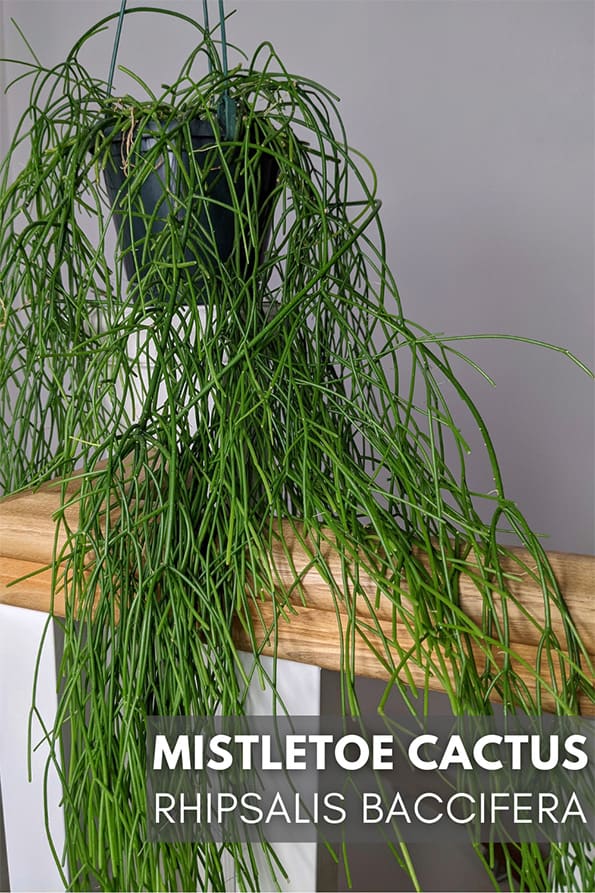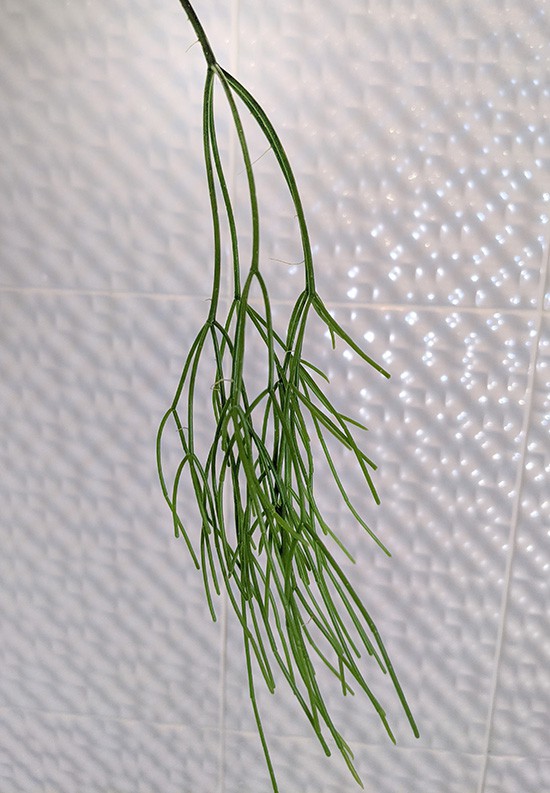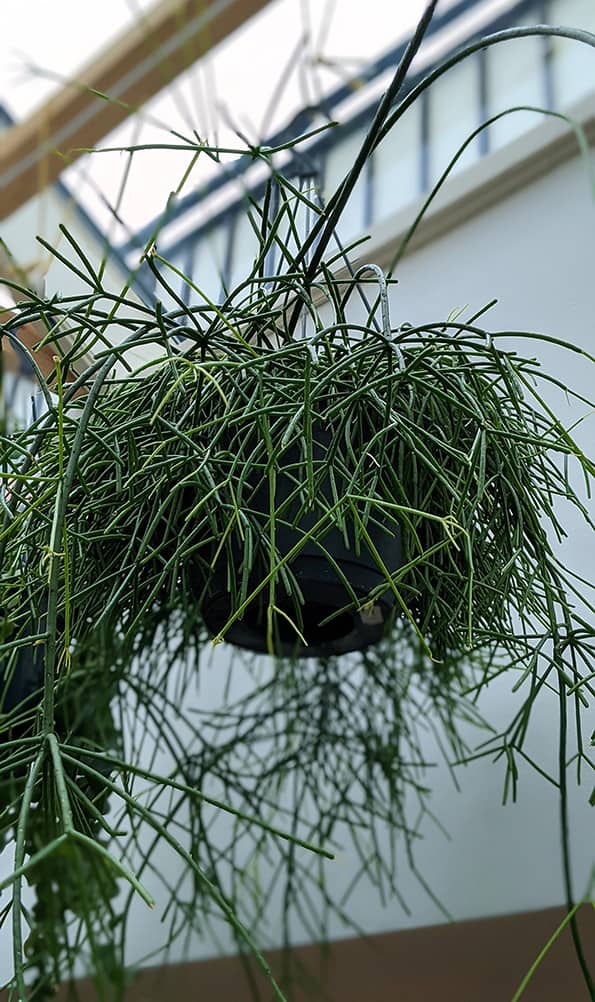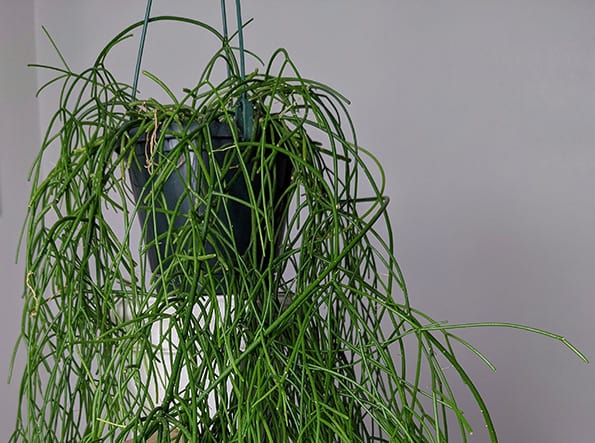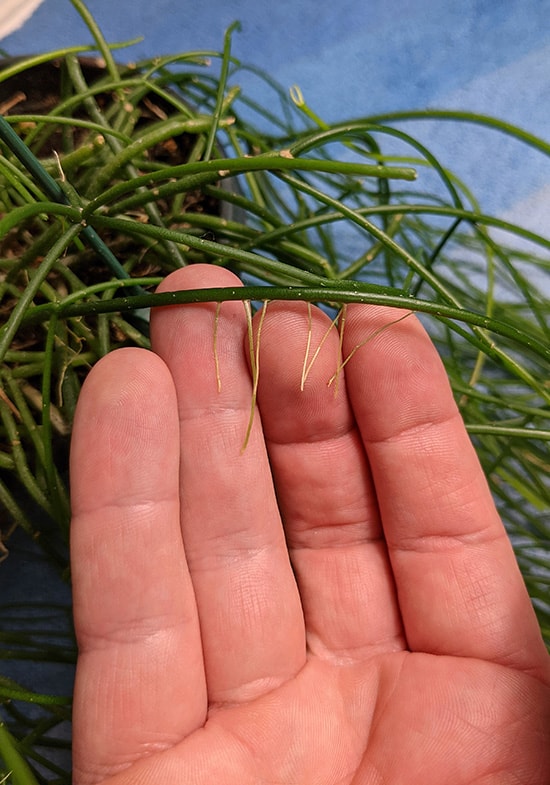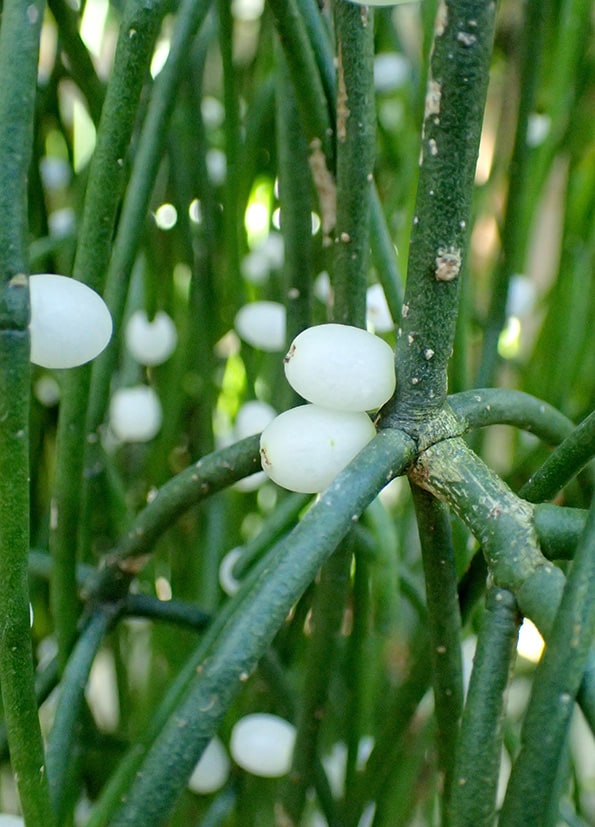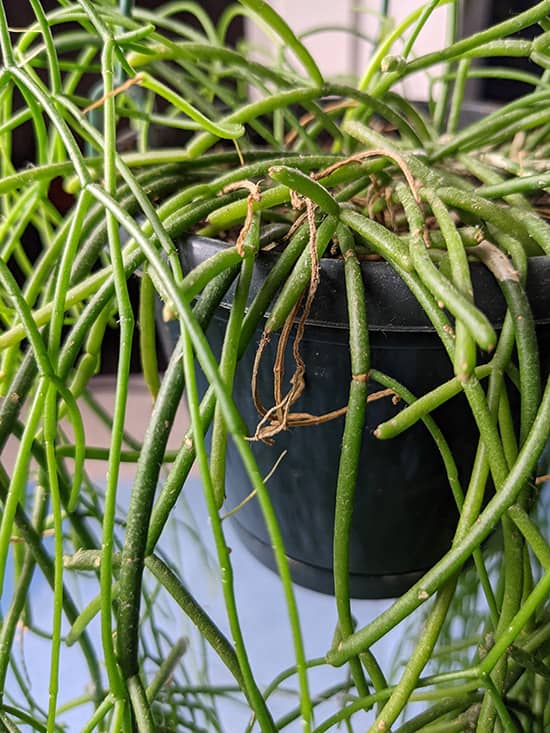The Mistletoe Cactus (Rhipsalis baccifera) is an intriguing houseplant known for its delicate, trailing stems and distinctive appearance.
The slender, hanging stems resemble mistletoe branches and produce white flowers and long-lasting berries. This is also how the "Mistletoe Cactus" got its common name.
It's an epiphytic cactus (it does not need a traditional potting medium to grow), but adapts very well to hanging baskets or containers, cascading gracefully as it grows.
It's an easy going indoor plant if you can meet the basic care needs. Mimic its native forest environment by providing warm temperatures, average light levels and well-draining soil. If you can tick off these basic requirements you should get along fine with this plant.
Native to Central and South America, particularly the rainforest's of Brazil. Rhipsalis baccifera belongs to the Cactaceae family.
However, it differs from typical desert cacti because it prefers more tropical conditions and is less tolerant of full sun and long periods of drought.
How do you pronounce Rhipsalis baccifera correctly?
Say:
Rip-Sar-Liss BAC-eee-fer-rar.
The Mistletoe Cactus is relatively low-maintenance and makes an excellent display for hanging baskets or placed on shelves, where its trailing stems can cascade freely.
Is the Mistletoe Cactus an easy plant to own?
I've owned my Rhipsalis baccifera for several years now and I've not treated it perfectly. However it's still going strong and with all things considered I would put this in the "very easy" houseplant category.
Rhipsalis is a popular genus with many species suiting indoor situations. However, they can look similar, and several look very similar to Rhipsalis baccifera. Some even have the same common name (Mistletoe Cactus), making identification difficult.
The plant is often confused with one of the following three.
- Rhipsalis cereuscula
-
Rhipsalis burchellii
-
Rhipsalis campos-portoana
There are also subspecies of Rhipsalis baccifera that are grown as houseplants, such as the Mouse Tail Cactus (Rhipsalis Baccifera Horrida).
The cylindrical stems tend to split every so often and the new growth will quickly help to create a bushy and full look. This is why mistletoe cacti look so great in a hanging basket or dangling over a shelf edge.
Distinguishing Rhipsalis baccifera from other species can, unfortunately, pose a challenge.
Typically, the mistletoe cactus plant will feature numerous slender, hanging, branched, cylindrical stems, reaching up to 0.2 inches (0.5 cm) in diameter. These stems fork periodically into pairs or clusters from the ends of mature branches. You can see this happening in the photo above.
Generally even if you have a different species or not the true Mistletoe Cactus, Rhipsalis care requirements are identical or at least very close. I'll go through these next.

Hi, I'm Tom!
If you're like me and enjoy the challenge of growing houseplants and getting them to thrive, then Ourhouseplants can help. This website shares my knowledge and years of growing plants and provides (hopefully) helpful advice on properly caring for your indoor plant friends.
In its natural habitat, the Mistletoe Cactus is a jungle cacti and grows beneath the canopy of trees, receiving filtered sunlight. Avoid placing it in direct sunlight, as this can lead to sunburn or leaf damage.
It can also tolerate lower light conditions, making it suitable for indoor environments with moderate light levels.
If the plant's growth becomes leggy or sparse, or bits start falling off, it may indicate insufficient light. If you see these things happening, move it to a brighter location, and it should bounce back.
Although the Mistletoe Cactus has Cactus in its name, it doesn't have the same light requirements. In fact it will struggle in full sun. In its native habitat, it's partly shielded by the canopy of forests and jungles.
Something to look out for.
Sometimes you'll see small, hair-like roots growing from the plant's stems. This could be a sign that you need to provide more humidity or water for your plant.
If your Rhipsalis plant is a reasonable size and is growing in a smaller container, I've found them to be moderately thirsty plants.
Small plants or those in larger planters will take longer to dry out and need much less frequent watering. The same goes for the winter months when they will often stop growing.
Generally I don't soak the potting mix like I might with some of my other houseplants. I give it a gentle water and stop. The root ball doesn't need to be "evenly moist" all the way through.
The reason I do this is because they're epiphytes and will take whatever they can get, whether that's a splash or a mini drench. However most people, myself included, grow them in regular potting mix (it's how they often come when brought too).
Regular potting soil tends not to have good drainage. Great for plants that love lots of moisture around the roots, not so brilliant for plants that are adapted to a little less.
Too much water around the roots of mistletoe cacti with this type of potting medium can cause root rot. So, by watering it gently, I've prevented this from happening.
The Mistletoe Cactus generally appreciates higher humidity levels, mimicking its natural habitat in tropical regions.
For a tropical plant, it can surprisingly tolerate average indoor humidity levels well. So unless you notice things not looking good for your plant, I wouldn't suggest the average grower needs to alter the humidity levels around their plant artificially.
This Rhipsalis is adapted to nutrient-poor environments, and does not require frequent or heavy feeding.
Providing a regular balanced fertilizer at a reduced strength and frequency during the growing season can help support healthy growth and potential flowering without overwhelming the plant with excess nutrients.
Rhipsalis plants often grow well indoors and are generally considered to be very low-maintenance plants.
To help promote healthy growth aim for temperatures between 65°F (18°C) and 80°F (27°C) during the day. It can tolerate cooler temperatures at night, but ideally not lower than 55°F (13°C).
Dips outside of these ranges occasionally won't be a problem. But avoid extreme temperatures, especially anything considered "cold".
You won't need to repot your plant frequently. They're pretty happy in smaller containers and don't mind some root restriction. Anything from 2 - 4 years is considered normal.
Look to repot when the plant has clearly stopped growing, or the potting mix has shrunk or broken down.
You can watch me talk about this plant on my YouTube channel..
The Mistletoe Cactus, is an epiphytic plant and theoretically doesn't need any soil or potting mix to grow well. However as a houseplant, most owners will want to use a potting mix.
This helps keeps the plant stable and reduces the need for daily watering.
With that in mind, it's probably best (and it's my official recommendation to new owners unfamiliar with this plant) to use a well-draining potting mix that replicates its natural growing conditions such as a cactus and succulent potting mix.
But, you don't have to if you're careful. I have mine growing in quite a dense soil and it's been like that for years and is doing fine. The key is to be extra careful with the watering. You don't need to flood the soil with water. Doing it sparingly is enough to gently wet the mix slightly.
You can propagate new plants pretty easily through stem cuttings.
Select a healthy stem from the plant that is at least a few inches long. Ensure the stem is free from any signs of damage or disease. Browning or yellowing stems are unlikely to do anything.
Using clean, sharp scissors or pruning shears, cut the stem a little below a leaf joint or node. This is where new roots will develop. If you want, you can allow the cut end of the stem to callus over for a few days to reduce the risk of rotting.
Top Hack.
One single stem cutting will take ages to create a full looking plant. You can speed things up by putting several cuttings into one pot at the same time.
Prepare a small pot filled with well-draining cactus or succulent potting mix. Plant the cut end of the stem into the potting mix, burying it just deep enough to provide stability.
Water the newly planted cutting lightly and place it in a warm, bright location with indirect sunlight. Keep the soil lightly moist but not soggy, and avoid overwatering to prevent rotting.
Sometimes the plant will start producing roots like this naturally. You can use these stem sections for propagation. Just gently lie the stem onto moist potting mix so the roots are touching it. They will then root fully and start to establish a new plant.
It's a slow to moderate grower compared to some other houseplants. The plant care and other environmental conditions you provide can affect this. For example cooler temperatures, or lower light levels will slow down growth rates.
If you need some pointers to try and increase it's growth potential, check out this guide for some tried and tested tips.
The plant is known for its trailing or pendant growth habit, which allows it to cascade gracefully from hanging baskets or containers. They can reach impressive lengths over time. Up to 6 feet.
Although my plant is no where near that long (yet) I don't think I would have the space for that. If you have similar concerns, then you can prune them down if they get too long.
Did you Know?
The species name "baccifera" is taken from the Latin word bacca, meaning "berry", and ferrer, "to bear". This is in respect of its flowering and berry trait.
The Mistletoe Cactus produces small, delicate flowers. These flowers typically bloom in clusters along the stems, often appearing in white or cream hues, although some crosses and cultivars may feature pink or yellow blooms.
Blooms usually emerge during the spring and summer months. A short time later, berries will form that will stay on the plant for months on end.
After the flowers are over you can expect white berries to form on the succulent stems. Photo by Krzysztof Ziarnek
The plant and the berries are generally considered non-toxic to pets such as cats and dogs.
While ingesting small amounts of the plant is unlikely to cause harm, it's always a good idea to prevent pets from nibbling on houseplants whenever possible. Some pets may have sensitivities or allergies to certain plants or give them a bad belly.
You can absolutely prune the plant's stems if they get too long for the space. The cuttings can be used to propagate new plants too. Just remember it's a slow-growing plant and so it could take a while to regrow whatever you remove.
Dropping Stems.
These plants tend to hold on to their leaves well. If segments are falling from your plant whenever you gently brush past it then you probably have a problem.
The most common reason this happens is down to being placed in low light locations for long periods. Extreme underwatering can also trigger parts of the plant to fall off.
Brown Stems / Yellow Stems.
This isn't always an issue as stems will go brown occasionally. However, it's worth checking the other reasons this happens and seeing if you think they're affecting your plant.
Even with proper care some browning like this is generally to be expected.
Red Stems
The Mistletoe Cactus dislikes intense strong sunlight. If the light levels increase too much, the stems will often take on a red or purple hue.
In some instances this can be reversed if you pull the plant back from the sun and re-home it somewhere a little shadier. After a few weeks the red should gradually change back to the familiar healthy green.
Wrinkly Stems
In most cases, shriveling or wrinkling stems on your Mistletoe Cactus will be a sign of underwatering. Give it a good drink and they should plump back within a few days.
Credit for Mistletoe Cactus Berries Photo by Krzysztof Ziarnek
